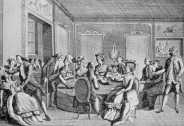HISTORY OF ANAESTHESIA - lecture handout, ODP course Bristol 18/01/02
You can click on any of the pictures to get an enlarged view
Ancient and Mediaeval times
Drugs available for relief of pain
Alcohol
Opium (Poppy)
Hyoscine (Mandrake + others)
Cannabis (Hemp)
Cocaine – in New World only
Henbane
Hop & Hemp
Poppy
Non drug methods
Cold
Concussion
Carotid compression
Nerve compression
Hypnosis
Blood letting
Clamp for compression anaesthesia
Leading up to 1846
1516 action of curare observed
1540 ether synthesised
1562 Paré used nerve compression
1628 Harvey described circulation of blood
1665 first IV injection – opiate through a quill
1772 Mesmer – ‘animal magnetism’
1777 Priestley prepares N2O
Humphry Davy
Henry Hill Hickman
1800 Davy described analgesic action of N2O
1800+ laughing gas and, later, ether used as social intoxicants
1807 Larrey - snow for amputations
1821 Brodie gives ether to guinea-pigs;
1842 Hickman uses CO2 on animals
1831 Guthrie et al - Chloroform synthesised
1842 Clarke and Long used ether for operations; unreported
Crawford Long
Horace Wells
1843 First FRCS – before both anaesthesia and antisepsis!
1844 Wells used N2O; public demonstration at MGH ‘failed’; cries of “Humbug”
1845 Esdaile – 73 operations under hypnosis
1826–45 at the Mass. Gen.Hosp. there were only 333 operations over 20 years.
William Morton
Charles Jackson
Mesmer practising Animal Magnetism
Pneumatic Institute, Bristol
Social Note
In the 17/18th centuries: public executions = entertainment.
Before 1846 there had been 25 years of peace, rapid industrialisation and rapid growth of towns.
By 1830 there was overcrowding, not enough clean water, poor sewerage; not enough graveyards.
In 1833 the Factory Act was passed; 1841-48 the Mines Act, Ten Hours Act, Public Health Act.
October 16th 1846
First successful public demonstration of anaesthesia
Massachusetts General Hospital, Boston
Anaesthetist: William Thomas Green Morton
Agent: Diethyl Ether
Patient: Gilbert Abbott
Operation: Excision of tumour under jaw
Surgeon: John Collins Warren
Comment: “Gentlemen, this is no humbug”
painting by Robert Hinckley
a replica of Morton's inhaler
Ether dome c. 1930
Anaesthesia Memorial, Boston
photo by Whelan Moore
Inscription on Morton’s tombstone:
Inventor and Revealer of Inhalation Anesthesia: Before Whom, in All Time, Surgery was Agony; ByWhom, Pain in Surgery was Averted and Annulled; Since Whom, Science has Control of Pain.
Some events after 1846
1847 Simpson
1847 Snow
1847 Snow
1848 Heyfelder
1854 Snow
1865 Lister
1878 Macewen
1884 Koller
1891Tuffier
1892 Schleich
1894
1897
Chloroform
On the Inhalation of Ether
chloroform regulating inhaler
Ethyl chloride used in Germany
Broad St pump-handle removed
carbolic spray
first oral ETT; flexible brass, 3/8" diam
cocaine
first partial pneumonectomy; no ETT
infiltration LA
anaesthetic charts
first death from a motor car
James Simpson
1895 Corning
1898 Bier
1904
1907
1920 Rowbotham
1921
1934
1937 Macintosh
spinal anaesthesia for relief of pain
spinal anaesthesia for surgery
procaine – a huge advance
intra-tracheal insufflation (chloroform)
blind nasal intubation with wide bore tube
lumbar epidurals
cyclopropane, thiopentone
1st European chair of anaesthesia
John Snow
1941
1942
1946
1951
1952 Ibsen
1956 Johnstone
1980 onwards
Trilene
curare first used in anaesthesia
lignocaine
suxamethonium
IPPR for bulbar poliomyelitis
introduces halothane
use of halothane declines, as new ethers introduced
Acknowledgement of source of pictures: Wells and Morton are from the Clendenning library; Morton's inhaler and Jackson from http://neurosurgery.mgh.harvard.edu/History; compression clamp, Hickmann, Simpson, Snow, Koller, Corning and the Ether Dome from Victory Over Pain by Victor Robinson. Sigma, London 1947; Davy from Bristol City Museum; Hinckley painting from Countway Library of Medicine.
Part 2 of this lecture handout is a comparison of anaesthetic agents available in 1847
Part 3 of this lecture handout is on the stages of anaesthesia
Home (to visit other articles/book on the history of anaesthesia)
e-mail: john@johnpowell.net
















